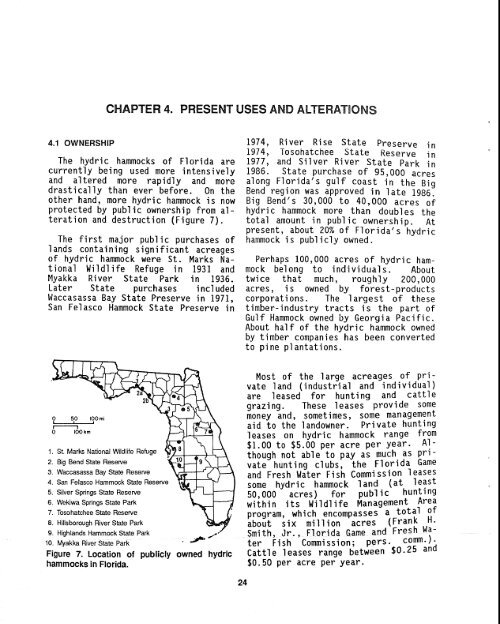a Guide to Management - USGS National Wetlands Research Center
a Guide to Management - USGS National Wetlands Research Center
a Guide to Management - USGS National Wetlands Research Center
You also want an ePaper? Increase the reach of your titles
YUMPU automatically turns print PDFs into web optimized ePapers that Google loves.
4.1 OWNERSHIP<br />
CHAPTER 4. PRESENT USES AND ALTERATIONS<br />
The hydric hammocks of Florida are<br />
currently being used more intensively<br />
and altered more rapidly and more<br />
drastically than ever before. On the<br />
other hand, more hydric hammock is now<br />
protected by public ownership from al-<br />
teration and destruction (Figure 7).<br />
The first major public purchases of<br />
lands containing significant acreages<br />
of hydric hammock were St. Marks Na-<br />
tional Wildlife Refuge in 1931 and<br />
Myakka River State Park in 1936.<br />
Later State purchases included<br />
Waccasassa Bay State Preserve in 1971,<br />
San Felasco Hammock State Preserve in<br />
1. St. Marks <strong>National</strong> Wildlife Refuge<br />
2. Big Bend State Reserve<br />
3. Waccasassa Bay State Reserve<br />
4. San FeEasco Hammock State Reserve<br />
5. Silver Springs State Reserve<br />
6. Wekiwa Springs State Park<br />
7. Tosohatchee State Reserve<br />
8. Hillsborough River State Park<br />
9. Highlands Hammock State Park<br />
10. Myakka River State Park<br />
. sL. "'<br />
Figure 7. Location of publicly owned hydric<br />
hammocks in Florida.<br />
1974, River Rise State Preserve in<br />
1974, Tosohatchee State Reserve in<br />
1977, and Silver River State Park in<br />
1986. State purchase of 95,000 acres<br />
along Florida's gulf coast in the Big<br />
Bend region was approved in 1 ate 1986.<br />
Big Bend's 30,000 <strong>to</strong> 40,000 acres of<br />
hydric hammock more than doubles the<br />
<strong>to</strong>tal amount in publ ic ownership. At<br />
present, about 20% o f Florida's hydric<br />
hammock is publ icly owned.<br />
Perhaps 100,000 acres of hydric ham-<br />
mock belong <strong>to</strong> individuals. About<br />
twice that much, roughly 200,000<br />
acres, is owned by forest-products<br />
corporati ons. The 1 argest of these<br />
timber-industry tracts is the part of<br />
Gulf Hammock owned by Georgi a Pacific.<br />
About half of the hydric hammock owned<br />
by timber companies has been converted<br />
<strong>to</strong> pine plantations.<br />
Most of the large acreages of pri-<br />
vate 1 and (industrial and individual )<br />
are leased for hunting and cattle<br />
grazing. These leases provide some<br />
money and, sometimes, some management<br />
aid <strong>to</strong> the landowner. Private hunting<br />
leases on hydric hammock range from<br />
$1.00 <strong>to</strong> $5.00 per acre per year. Al-<br />
though not able <strong>to</strong> pay as much as pri-<br />
vate hunting clubs, the Florida Game<br />
and Fresh Water Fish Commission leases<br />
some hydric hammock land (at least<br />
50,000 acres) for pub1 ic hunting<br />
within its Wildlife <strong>Management</strong> Area<br />
program, which encompasses a <strong>to</strong>tal of<br />
about six million acres (Frank H.<br />
Smith, Jr., Florida Game and Fresh Wa-<br />
ter Fish Commi ssion; pers. comm. ) s<br />
Cattle leases range between $0.25 and<br />
$0.50 per acre per year.

















